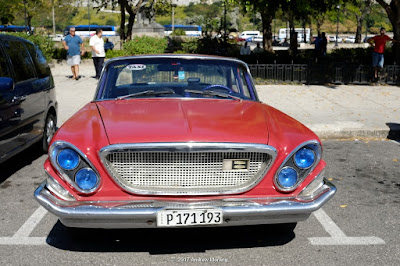Almost no one can fail to be impressed with the monstrous 1950s American cars trundling around Havana. We forget what exuberant styling, chrome, and just plain mass was built in these examples of the American post-war economic boom. (Of course, many of the bulbous contemporary SUVs that clog American cities and gated McMansion communities have almost as much mass, but they totally lack creative styling and paint schemes; black, gray, and white seem to do it for the contemporary suburban poseur.)
 |
| Oops, a Morris. A rare example of old English iron instead. |
The majority of older cars we saw in Cuba were Chevrolets and Fords. There were a scattering of Buicks, Edsels, and Chryslers. I was surprised to see almost no Volkswagen Beetles and maybe one Mercedes. Also, I only saw 2 or 3 Peugeots in three weeks. Russian (or Polish?) Ladas were just about the only "modern" cars we saw. By far the worst polluters were old Soviet trucks. Recently, the Cuban government has imported Chinese minibuses for tourist transport, and some of the recent taxis are from Korea.
Her are some of the Fords. Considering Havana is a seaside city, the preservation of the chrome is impressive.
Aha, an Edsel. What a styled machine with its odd vertical radiator grill clashing with the horizontal bezels for the twin headlights. A friend in Massachusetts owned one, and I recall the push-button transmission buttons in the middle of the steering wheel, where most drivers are used to seeing a horn button. Ford had to install a safety interlock system.
 |
| A Chrysler 300. I hope it retained its original engine. The blue headlights are a bit odd. |
Some of these cars have their original engines. That has become a tourist draw. But because of the 60-year embargo of trade from the USA, Cuban drivers have been innovative about parts and mechanical components. One of those "innovations" was installing 4-cylinder Lada engines in place of the original Detroit engines. From what I could see (and smell), the Lada power plants spewed more emissions than the US engines.
The Buick Eight. These were
big bruisers. They would have been perfect for cruising Ike Eisenhower's new Interstate system.
Here are the handsome and roomy 1950s Chevrolets. Back in the 1950s and 1960s, they offered a lot of transportation to young families. That was the brilliance of the General Motors marketing machine: sell them a nice but basic car when they are young, then offer increasingly upscale cars such as Oldsmobile and Buck when they get more prosperous. And ultimately, move them into a Cadillac so that they can demonstrate that they "have made it." The model still works: the grotesque luxury SUV is the contemporary "made it" demonstration device for the pretentious poseur set.
Dear Readers, we have finished our tour of western Cuba and Havana. If any of you are interested in visiting, do it
soon, before the commercial interests start building vacation condominiums, erecting nasty fast food restaurants, and pillaging the environment. Maybe the Cuban government can balance development with retention of the best aspects of their nature and culture - I truly hope so. And what if the embargo ends? As Joe Klein wrote in
Time Magazine, Dec. 1, 2016:
"The Castros needed the American Satan and its embargo as an excuse for their socialism-induced poverty and martial law. They would never be able to withstand the tide of freedom--and commerce--that would wash over the island."
Well, that tide may be about to overwhelm.
As of 2017, the Cuban people are gracious and welcoming, travel is easy, food is OK, accommodations variable, and toilets terrible. Don't let any of that scare you, just go and
have fun.
These are digital images from my Fuji X-E1 digital camera.





